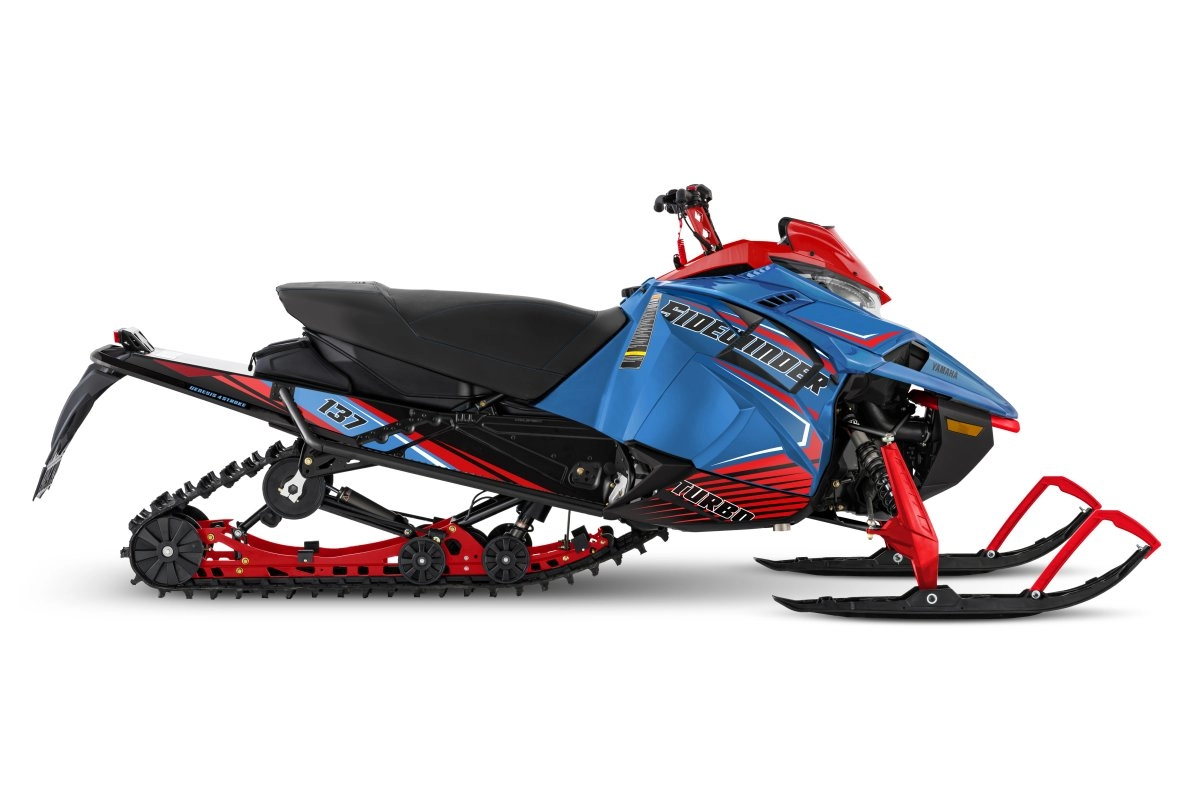2024 SIDEWINDER L-TX SE
KEY FEATURES
Comfort
The handlebar controls feature a left-hand switch cluster which allows for 'on-the-fly' access to the multi-step hand and thumb warmer adjusters. Information available on the multi-function gauge can be easily selected with a convenient toggle switch and the push button electric start, reverse gear switch is also located in the left-hand cluster. The right side of the bar is clean with an ergonomically shaped throttle lever and simple, stand-alone engine stop switch. The Hayes 'Stealth' brake cylinder is equipped with a composite brake lever providing great modulation for better feel and powerful stopping performance.
Convenient handlebar positioning makes starting, shifting to and from reverse easy with just the push of your thumb. A servo motor shifts the drivetrain into reverse simply and consistently. An audible warning beeper reminds you when you are still in reverse.
The Sidewinder's lightweight, two-piece, tapered tunnel gives you strength for the long haul and a tapered fit for enhanced leg comfort and overall ride positioning. The reinforced running boards are punched with aggressive boot hold serrations and offer excellent snow evacuation to keep your feet planted where you want them.
Handling
The straight steering post on the Sidewinder is configured over the engine. It connects to a single bell crank for simplicity and light weight. The design also minimizes free-play in the steering system and delivers a tight turning radius.
Overall ski stance is also adjustable by relocating the thick spacer located on each ski axle to the opposite side
A special shim pad assembly works in conjunction with the rubber saddle block to adjust the carbide pressure point.
Unique, staggered carbides further enhance steering response.
The Yamaha designed single keel ski strikes the elusive balance between lightweight steering effort and precision handling over a wide range of snow conditions.
Regarded as the best high-performance terrain track available, the 137 x 1.25-inch lug design of the RipSaw II delivers incredible acceleration, braking control and handling in a wide variety of conditions.
The SRV chassis combines a load-bearing triangulated structure with lightweight aluminum construction to create a neutrally balanced sled that's centered on the rider. The pyramidal upper frame creates chassis strength without excessive weight.
The SRV chassis layout was engineered with the goal of centralizing mass. Approximately 60 percent of the sled's weight is tightly centered within the main triangulation. The result is a quick-handling, well-balanced sled that's fun to throw around in a wide variety of conditions.
Performance
The YSRC primary and roller secondary clutches are calibrated for durable, cool operation. They harness and transfer the massive torque produced by the Genesis Turbo efficiently to the track while minimizing drive belt wear. The primary shifts out aggressively to use all the power on tap while the roller secondary is quick to back-shift and provides additional ratio through its oversize sheaves to keep accelerating long after the others have signed off.
Engine coolant is circulated through the turbocharger to control both under-hood temperature and help cool the intake charge. Upon engine shut down, the convection energy produced by super-heated coolant at the turbo head keeps it circulating without the coolant pump in operation. This eliminates the need for an engine cool-down cycle while maintaining high durability in the turbo components.
Unlike conventional turbo 'blow-off' valves, the Yamaha ABV redirects air pressure back into the intake side of the compressor to prevent surge and help maintain impeller speed, resulting in ready acceleration and seamless power delivery.
Yamaha engineers wanted an engine that's exceptionally quick to respond with little or no 'lag' as found in a conventional turbo. One of the ways they achieved their goal was to develop an intake system using three separate throttle bodies positioned very close to the intake valves, instead of just one feeding long intake tubes. It’s an innovation not seen in any other production turbo on the planet, and another first for Yamaha with the Genesis turbo.
The Yamaha-developed Mitsubishi ECU uses a series of nine sensors to gather running condition data which it computes using a predetermined memory ‘map’. It then adjusts ignition timing, fuel delivery, manifold air pressure and turbo boost pressure to produce maximum performance under any condition—reliably.
The nickel alloy turbine body is extremely strong and precise, able to withstand highly elevated temperatures. Supported by premium, ceramic ball bearings, the Inconel turbine blade assembly is very light and strong. This yields a low moment of inertia for lightning quick response to exhaust gas input. Triple throttle bodies are used exclusively to further enhance the quick delivery of compressed air from the impeller to intake valves.
*Manufacturer's Suggested Retail Price (MSRP) shown. Does not include tax, title, prep or destination charges. Actual prices set by dealer.
**Fuel Economy is estimated.
***Wet weight includes the vehicle with all standard equipment and all fluids, including oil, coolant (as applicable) and a full tank of fuel. It does not include the weight of options or accessories. Wet weight is useful in making real-world comparisons with other models.
